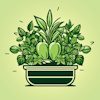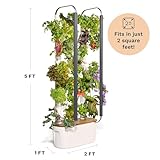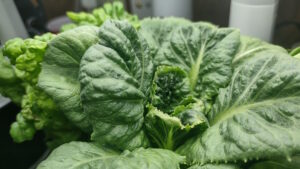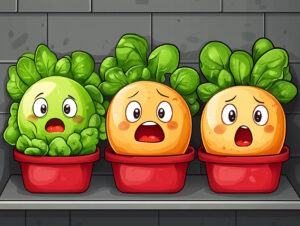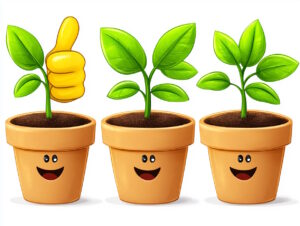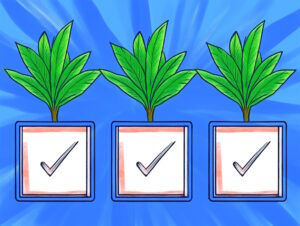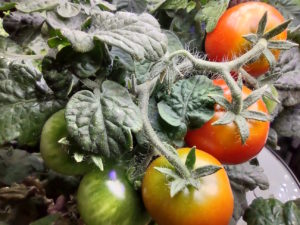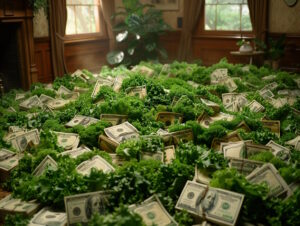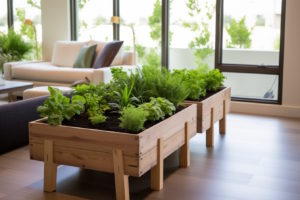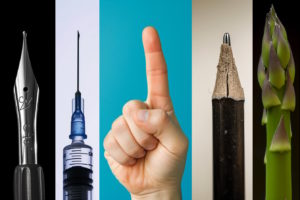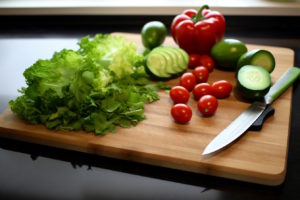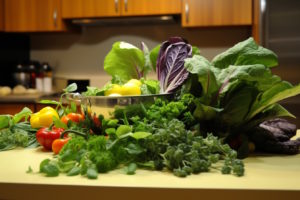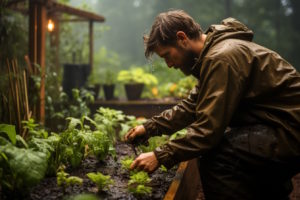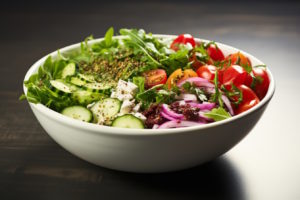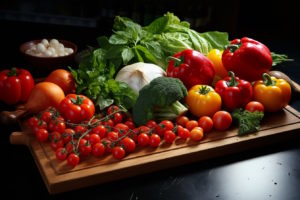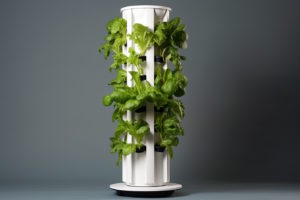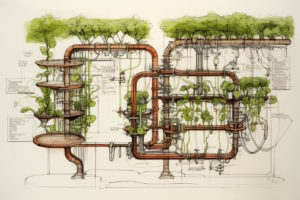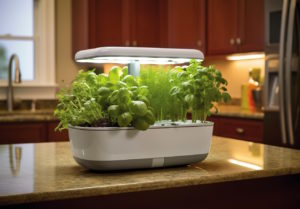Tips For Growing A Bountiful Indoor Garden
Your bountiful indoor garden will be your pride and joy. Whether you want to grow a few select herbs in a tasteful kitchen setting or you want to cram as many salad plants into as tight a space as possible, you’ll find ideas to help you succeed on this page.
This article will grow over time. New tips appear at the top of the page, so you don’t need to hunt them down each time you return.
There’s no shame in adding grow lights to your plants, even those in Hydroponic Growing Systems. If you have a full garden growing in a Hydroponic Growing System, the additional light can give your plants a boost.
I’ve grown tomatoes and peppers in AeroGarden Harvest series Hydroponic Growing Systems. Those plants grow so big! I prune to keep them in check, but I’ve found branches growing outside the scope of the light survive just fine. All the same, when I have a few larger plants arranged in close proximity, I believe having an independent grow light aimed at the lot of them provides a boost.
You’ll need to attach supplementary lights to a timer set to roughly match the schedule of the automated light. Your plant needs time to rest. The lights don’t need to be exactly synchronized, but the timers should be closely aligned.
Your Hydroponic Growing System has a very bright LED grow light. Or you added a LED grow light for your EarthBox or vertical garden. Get the most of your light by positioning other plants nearby. They won’t get direct light from the LED but it should be enough for many types of plants.
Position two or more lights close together and fill the space between them with planters. If you have three or more grow lights, you get a central growing area by arranging the lights in a circle. The light in the circle center will not be as bright as a dedicated light but it’s enough for some plant types.
Grabbing some free sunlight doesn’t hurt, either. Using artificial sunlight for your garden doesn’t mean you cannot make use of the real thing, too. Position your plants near a window facing south, west, or east for the most sunlight, but even a window facing north affords your plants a little extra “light food.”
Don’t throw away green onion bulbs after you cut off the stems! They may grow just fine in your Hydroponic Growing System.
Push the bulb down into an empty grow pod. You may fit more than one in a single pod. When the water circulates the Hydroponic Growing System will water the roots, which will grow down into the water in the tub. Pad the bulb with a grow plug cut in half if the bulb sits too low in the grow pod.
Other plants often regrown from stumps include celery and lettuce. You may find the size of the hole in the Hydroponic Growing System tray to be the limiting factor. But give it a try!
- NEXT-LEVEL GROW SYSTEM: Using Aerospring’s patented aeroponic technology, this all-in-one grow system doesn’t require any additional components to grow like a pro. The root zone is contained in the modular vertical pole, and allows the plant’s roots to grow to their greatest potential. In addition to the Aerospring aeroponic system, the grow kit comes with everything you would expect including: 180W grow light, quiet exhaust fan, carbon-filter, metal frame, D600 grow tent.
- HIGH QUALITY 180W LED GROW LIGHT: The all new, Aerospring Hexglow custom 180W custom LED light panel, full-spectrum, professional grow lights, highly efficient at 2.7 (umol/J), light intensity at 1272 PPFD (μmol/s) at 15in, CRI >90, CCT = 4000k, estimated lifespan 50,000 hours. Suitable spectrum for all stages of plant growth. 0-100% light dimmer included. Adjustable light height can be raised as the plant canopy grows.
- DESIGNED BY GARDENERS, FOR GARDENERS: We designed the Aerospring system to be the most usable hydroponic system. Easy access to the water reservoir for water management. The 20 gallon reservoir requires less frequent refilling. Easily detachable internal hose for draining/changing water. The vertical pole is easy to disassemble for cleaning and reassembly, and dishwasher safe. The wheelbase allows for easy movement and rotation for trimming leaves.
- TEMPERATURE CONTROLLED: 4" carbon air filter with Australia virgin charcoal, changeable pre-filter. Quiet 4" inline duct fan with 0-100% variable speed controller, cutting edge brushless EC Motor and dual jet type blades, delivers 160 CFM airflow rate using just 18 watts at maximum speed for discreet and high performance growing.
- GROW TENT FOR DISCREET GROWING: The fully sealable grow tent made with Oxford D600 tent material, with highly reflective white interior panels, increases plant growth while eliminating 100% of light seepage. Two colors available, gray and black, to fit with any interior.
- IN THE BOX: The Aerospring Grower’s Edition Indoor Hydroponic System includes the Aerospring patented vertical pole with 9 plant capacity, 20gal bucket & lid, Aerospring Hexglow custom 180W LED light panel and driver, Quiet 4" inline duct fan, 4" carbon air filter, Powder-coated metal hexagonal frame with wheelbase, Oxford D600 tent, Sicce Syncra Silent 1.5, Smart WiFi Power Strip, SCROG Net, 1L Aerospring Hexgrow (A&B) nutrients, LCD Hygrometer, 9 Grodan Rockwool cubes, 9 Grow cups. Warranty: 12 month manufacturer's warranty on all parts; 24 months manufacturer’s warranty on Hexglow LED light panel; 3+2 year manufacturer’s warranty on Sicce Syncra Silent 1.5 pump. Seedlings not included.
Avoid locating your plants near vents for heating and cooling. The air blowing from the vent can be as cool as the 50s to as high as the 90s Fahrenheit.
Provide your plants a location where the temperature is regulated but constant.
Some plants may harm children or pets. For each plant you decide to grow, do a quick Internet search for information whether the plant should be grown out of reach.
You can grow so many plants indoors, listing them all along with any possible adverse effects is not possible here. (Companion article: What Can I Grow with My Indoor Garden?)
Some plants may not be harmful to pets, but they certainly attract them. My cats enjoy chewing on the strawberry runners (and shoelaces, and just about any other strings). So, in addition to protecting your pets from your plants, protect your plants from your pets.
Healthy, happy plants grow tall and wide. This is what you want. But if your plant fills a corner with walls on two sides, you cannot get to all the goodies it grows.
A tomato plant can hide ripe cherry tomatoes better than you may realize. You may not see the little orange beauties due to the dense vegetation. And if you do see them you need to reach through the plant to grab them.
Position your plants where you have access to them from all sides. You can examine the plant from all angles so you miss no ripened fruits.
Your tomato or pepper plants can continue giving you fruits for months. You risk damaging your plants when you move them.
Therefore, when starting a plant that will be large and long-living, find a location for your plant where it can reside for as much as six months, or maybe even more.
Think in three dimensions. This isn’t a plowed field. Stack your gardens.
Countertop Hydroponic Growing Systems fit on shelves. They’ll fit on a narrow rack. Just be sure the spacing between the shelves accommodates the light when fully extended.
The AeroGarden Farm series of Hydroponic Growing Systems are floor models that stack using a simple bracket kit. Imagine two 24-pod gardens stacked vertically, growing food all year long. That’s a very compact, indoor, self-contained garden!
Another option is to grow plants on a column (tower) garden. Rather than arranging your plants on a flat tray, position plants around a column that stands two to six feet tall. You can grow many plants without taking up more than a few square feet of floor space. (Companion article: Limited Floor Space? Go Vertical With Your Garden!)
Don’t limit yourself to growing your food in the kitchen just because you are growing food. Plants add character to any room.
Decorate your home with leafy greens where you have limited space and jalapenos where a plant has room to expand.
Grow a cucumber plant and spread the vines out from the Hydroponic Growing System. So long as the vines get adequate light and you support the cucumbers it’s not much different than a spider plant. But with pretty yellow flowers! Be creative. Think outside the box.
Choose plants with similar growth characteristics if they share a hydroponic growing system or EarthBox. You want your plants to reach maturity around the same time, to share the light, and to expect the same watering schedule. Don’t plant a desert and tropical plant side-by-side! Or a short and a tall plant. Or a slow-grower and a fast-grower.
Be realistic in what you can grow and when in your Hydroponic Growing System.
You can grow other plants with your dwarf tomato plant if you have an AeroGarden Farm series garden or Hydroponic Growing System of similar capabilities. But if you have an AeroGarden Harvest or Hydroponic Growing System of similar capabilities you’ll need to cap five pod seats. The tomato plant will crowd out any other plants.
You are not always going to grow plants in every pod seat on the tray. Cap the pod seats to keep debris from falling into the water and prevent algae growth in the water.
You might think of plants like tomatoes, peppers, cucumbers, or even sunflowers as being too large to grow indoors. Most likely, you’ve seen these plants growing outdoors and they’ve been huge. But variations of all these plants and more have been bred for growth in tight spaces.
Seed pods you’d buy from AeroGarden include recommendations for the smallest Hydroponic Growing System series you’d want to grow them in. The AeroGarden tomato seed pod grows a plant that expands outside the range of the light of the Harvest series. Just prune a bit and the plant does just fine.
If you want to grow your own seeds in your Hydroponic Growing System, search for seeds using keywords such as “dwarf container seeds”.
When growing plants that grow a large trunk one thing to consider is the size of the openings in the tray for the pods. Watch to be sure the trunk does not grow too thick for the opening. You don’t want the plant trunk to crack the tray. You may never need to worry, but this is a page listing tips for getting the most from your Hydroponic Growing System, and this is a tip.
Why are you doing this? Are you happy planting random veggies and planning meals around what you have available? Or do you have a plan for everything you’re growing? You’ll get more from your indoor garden by having a plan for everything you grow.
Set objectives. Maybe you want a salad every day (Companion article: How to Get a Salad Every Day from Your Indoor Garden) or two. You want the perfect selection of herbs for your homemade dinners. Or ingredients for your salsa recipe. Or maybe a selection of finger food snacks to replace unhealthy treats. Decide what you need to grow and how to best achieve your objectives. (Companion article: How to Plan Your Indoor Garden)
Keep a journal. You cannot remember everything.
Use the journal to improve every crop. Just like a real farmer would.
Here are a few things you can track.
- When did you plant each seed?
- How long did the seed take to grow into a mature plant?
- How much nutrients did you add to the water, and when did you do it?
- How long did the plant survive?
- How many times did you harvest or how many fruits did you get?
You get the idea. Add your own questions to the list.
The point of this exercise is knowing what to expect when you start each seed. When you know what to expect from each plant you can plan your harvests to supply food for salads or meals. You know when to start new seeds to replace your existing plants to ensure no laps in your harvest.
You are growing food in a controlled environment. You can start a seed when you want and terminate the plant anytime. Experiment.
Try different plants. Which do you like better, the AeroGarden Red Heirloom or Golden Harvest tomato plant? Grow your own seeds for plants you don’t think will work well indoors.
Try pruning (or not pruning) the plants or adding supplemental grow lights if they are large plants.
Feed your plants nutrients from different manufacturers. Some people add small doses of hydrogen peroxide or calcium and magnesium to the water. Does that improve your crop yield? Or kill the plants?
Alter the feeding schedule. Is a fourteen day span between feedings optimal, or is it perhaps twelve days? For some plants, fourteen days between feedings works better, but maybe for others, half doses every seven days results in healthier plants.
It’s your garden. They’re your plants. You can grow your plants all year long. Try things out. Track your experiments and the results of your experiments. Over time, you’ll have that bountiful indoor garden you’ve longed for.
If a plant is not performing, kill it, clean the planter, and start over.
If your plants are growing outdoors, and it’s too late in the season to start over, you do whatever you can to revive your plants. That is the wrong way to think about an indoor garden.
With an indoor garden, there are no seasons. Keeping an ailing plant alive prevents you from starting over with a healthy replacement.
Be sure you know why the plant under-performed so your next attempt meets expectations. Think about the long term as you work to achieve your objectives. Your fifth crop should outperform your first crop. Yes, this is for fun, but it’s also about getting food you can eat.
When you garden outdoors, you plan around the four seasons. Plant in spring; harvest in summer and autumn; wait through winter for the next spring.
But your indoor garden enjoys a perpetual summer. You can start growing plants any time. Therefore, you should think in terms of cycles instead of seasons. A cycle is a round of growing food in your Hydroponic Growing System or Soil-Substitute Container.
You control the environment in which your plants grow. Take full advantage of this power. (Companion article: Why Your Outdoor Garden Should Be Indoors)
Plants eventually reach the end of their useful life. Learn to recognize the signs a plant is trending downward. Start a new crop cycle for that plant early enough that when the current crop cycle ends, you have a new crop cycle to replace it.
Your objective in overlapping crop cycles is to always have food to harvest. Sometimes that means leaving a pod seat in a tray empty for a little while so you have a place to start that new oregano plant as the existing one declines.
Since you are growing plants indoors, you probably won’t benefit from the efforts of natural pollinators like bees and butterflies.
Look for self-pollinating varieties of plants like cucumbers. They do exist. Pollinating this type of plant can be as easy as positioning a fan to blow air across the plant to jiggle the flowers. You can jiggle the branches yourself, if you wish.
In the absence of self-pollinating variants, you become the pollinator. You can use a cotton swab, an electric toothbrush, or an AeroGarden Be The Bee pollinator.
Research the plant so you understand how to identify male and female flowers and whether you need multiple plants to achieve pollination.
- Gardening system that can grow larger and longer root crops such as carrots, rutabagas and parsnips - or just a single Tomato!
- Includes: 4-piece gardening system (earthbox root & veg container, aeration screen, water fill tube, 2 B/w mulch covers), 1-pound fertilizer, 1-pound dolomite
- Made in United States
- Brand name: EarthBox
You may be able to save money when ordering an AeroGarden seed pod kit.
The AeroGarden Harvest has seats for six pods on its tray. Therefore, most people would look for a six pod kit when ordering refills. Stop! Compare the prices of the nine and twelve pod kits.
Take the total cost of the six pod kit and divide by 6. That is the cost per pod in that kit. Take the total cost of the nine pod kit and divide by 9. That’s the cost per pod in that kit. Which one is less expensive? Do the same for the twelve pod kit.
You may get more pods for just a few cents or dollars more. Why not? You save money and they’ll keep until you are ready to use them.
Be sure to check the contents of the different pod kits. The contents of the twelve pod kit may be different than two six pod kits. It depends on the kit.
Note that the number of fertilizer bottles in the different kits are designed for one cycle of the included pods. If getting a comparable amount of nutrients is important to you, be sure you are not saving money on the pods but losing money on the nutrients.
Do you start your spring outdoor garden with a trip to the nursery section of your local big box store? You pick out a selection of seedlings ready for transplant into your raised beds or patio containers. The price of those baby plants sure seemed to go up a lot in the last few years. Want to save some money?
If you have an AeroGarden Harvest, Bounty, or Farm series Hydroponic Growing System, you can swap out the regular tray with an optional tray designed for growing many seedlings for transplant.
How many seedlings can you grow?
- 23 seedlings in the Harvest
- 50 seedlings in the Bounty
- 85 seedlings in the Farm 12
- 170 seedlings in the Farm 24
How much would you pay to buy 170 seedlings at the big box store? Grow them from seed right in your own home! Seeds are so much less expensive.
And don’t stop with one batch of seedlings. After transplanting one batch of seedlings, just start on the next!
Key Takeaways
Gardening indoors is no longer a collection of struggling plants fighting for sunlight from a south-facing window in winter. There are so many new ways to grow food indoors now. I trust the tips provided in this article help you save some money while increasing the yield of your indoor garden.
Check back with this page periodically. I’ll add new tips at the top of the page.
Good luck, and have fun growing your own food.
Scroll down for more insightful articles related to your indoor garden.
Get More Indoor Garden Ideas Here
You Have A New Hydroponic Growing System. Now What?
You have a new indoor garden and high hopes. What do you do next?
Keep ReadingSurviving in a Post-AeroGarden World
AeroGarden announced its closing effective the first of January, 2025. Farewell, good friend.
Keep ReadingThe Most Reviewed Indoor Gardening Equipment
You don’t get thousands or tens of thousands of reviews by being a horrible product. What works? Find out here.
Keep Reading32 Factors to Consider When Setting Up Your Indoor Garden
Avoid making simple mistakes when you set up your indoor garden.
Keep ReadingYou Can Grow Tomatoes Indoors
You can grow delicious tomatoes indoors all year long, and it’s actually quite easy. Get started now!
Keep ReadingIs Indoor Gardening Expensive?
Is gardening indoors expensive? Relatively, no.
Keep ReadingA Raised Bed Garden Indoors? Bring It On!
Learn how to grow your food indoors using an indoor garden bed.
Keep ReadingTips For Growing A Bountiful Indoor Garden
Make your life easier and grow more food indoors with these tips, tricks, and suggestions.
Keep ReadingHow to Choose Your Hydroponic Growing System
Ready to buy a hydroponic growing system, but not sure what features matter? Start here!
Keep ReadingHow to Plan Your Indoor Garden
Get more from your indoor garden by gardening with a purpose.
Keep ReadingIndoor Gardens Aren’t Outdoor Gardens Indoors
When you grow your garden indoors, you leave the old traditions and limitations outdoors.
Keep ReadingHow to Get a Salad Every Day from Your Indoor Garden
You can grow an indoor salad all year long. Learn how!
Keep ReadingWhat Can I Grow with My Indoor Garden?
Spoiler alert: Almost anything! This is a LONG list. And it’s really easy.
Keep ReadingLimited Floor Space? Go Vertical With Your Garden!
Learn about vertical indoor gardens and discover your options.
Keep ReadingHow a Self-Watering Hydroponic System Works
Get the best self-watering hydroponic system by learning how they work.
Keep ReadingWhy Your Outdoor Garden Should Be Indoors
Bring your garden indoors for year-round produce without the back-aches.
Keep Reading
